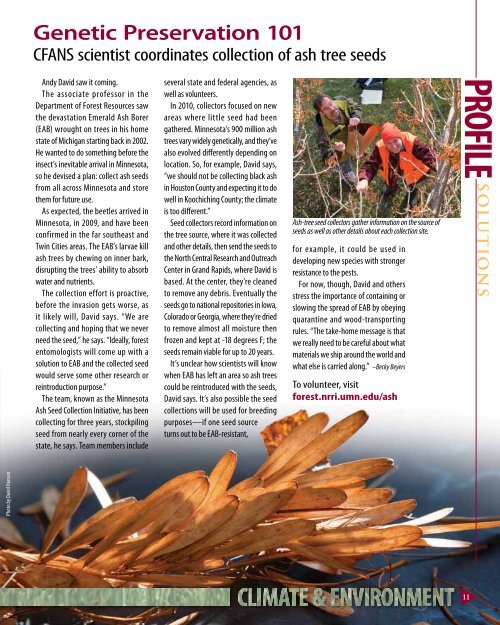PDF Version - College of Food, Agricultural and Natural Resource ...
PDF Version - College of Food, Agricultural and Natural Resource ...
PDF Version - College of Food, Agricultural and Natural Resource ...
You also want an ePaper? Increase the reach of your titles
YUMPU automatically turns print PDFs into web optimized ePapers that Google loves.
Photo by David Hansen<br />
Genetic Preservation 101<br />
CFANS scientist coordinates collection <strong>of</strong> ash tree seeds<br />
Andy David saw it coming.<br />
The associate pr<strong>of</strong>essor in the<br />
Department <strong>of</strong> Forest <strong>Resource</strong>s saw<br />
the devastation Emerald Ash Borer<br />
(EAB) wrought on trees in his home<br />
state <strong>of</strong> Michigan starting back in 2002.<br />
He wanted to do something before the<br />
insect’s inevitable arrival in Minnesota,<br />
so he devised a plan: collect ash seeds<br />
from all across Minnesota <strong>and</strong> store<br />
them for future use.<br />
As expected, the beetles arrived in<br />
Minnesota, in 2009, <strong>and</strong> have been<br />
confirmed in the far southeast <strong>and</strong><br />
Twin Cities areas. The EAB’s larvae kill<br />
ash trees by chewing on inner bark,<br />
disrupting the trees’ ability to absorb<br />
water <strong>and</strong> nutrients.<br />
The collection effort is proactive,<br />
before the invasion gets worse, as<br />
it likely will, David says. “We are<br />
collecting <strong>and</strong> hoping that we never<br />
need the seed,” he says. “Ideally, forest<br />
entomologists will come up with a<br />
solution to EAB <strong>and</strong> the collected seed<br />
would serve some other research or<br />
reintroduction purpose.”<br />
The team, known as the Minnesota<br />
Ash Seed Collection Initiative, has been<br />
collecting for three years, stockpiling<br />
seed from nearly every corner <strong>of</strong> the<br />
state, he says. Team members include<br />
several state <strong>and</strong> federal agencies, as<br />
well as volunteers.<br />
In 2010, collectors focused on new<br />
areas where little seed had been<br />
gathered. Minnesota’s 900 million ash<br />
trees vary widely genetically, <strong>and</strong> they’ve<br />
also evolved differently depending on<br />
location. So, for example, David says,<br />
“we should not be collecting black ash<br />
in Houston County <strong>and</strong> expecting it to do<br />
well in Koochiching County; the climate<br />
is too different.”<br />
Seed collectors record information on<br />
the tree source, where it was collected<br />
<strong>and</strong> other details, then send the seeds to<br />
the North Central Research <strong>and</strong> Outreach<br />
Center in Gr<strong>and</strong> Rapids, where David is<br />
based. At the center, they’re cleaned<br />
to remove any debris. Eventually the<br />
seeds go to national repositories in Iowa,<br />
Colorado or Georgia, where they’re dried<br />
to remove almost all moisture then<br />
frozen <strong>and</strong> kept at -18 degrees F; the<br />
seeds remain viable for up to 20 years.<br />
It’s unclear how scientists will know<br />
when EAB has left an area so ash trees<br />
could be reintroduced with the seeds,<br />
David says. It’s also possible the seed<br />
collections will be used for breeding<br />
purposes—if one seed source<br />
turns out to be EAB-resistant,<br />
Photo by David Hansen<br />
Ash-tree seed collectors gather information on the source <strong>of</strong><br />
seeds as well as other details about each collection site.<br />
for example, it could be used in<br />
developing new species with stronger<br />
resistance to the pests.<br />
For now, though, David <strong>and</strong> others<br />
stress the importance <strong>of</strong> containing or<br />
slowing the spread <strong>of</strong> EAB by obeying<br />
quarantine <strong>and</strong> wood-transporting<br />
rules. “The take-home message is that<br />
we really need to be careful about what<br />
materials we ship around the world <strong>and</strong><br />
what else is carried along.” –Becky Beyers<br />
To volunteer, visit<br />
forest.nrri.umn.edu/ash<br />
PrOFilE solutions<br />
11

















